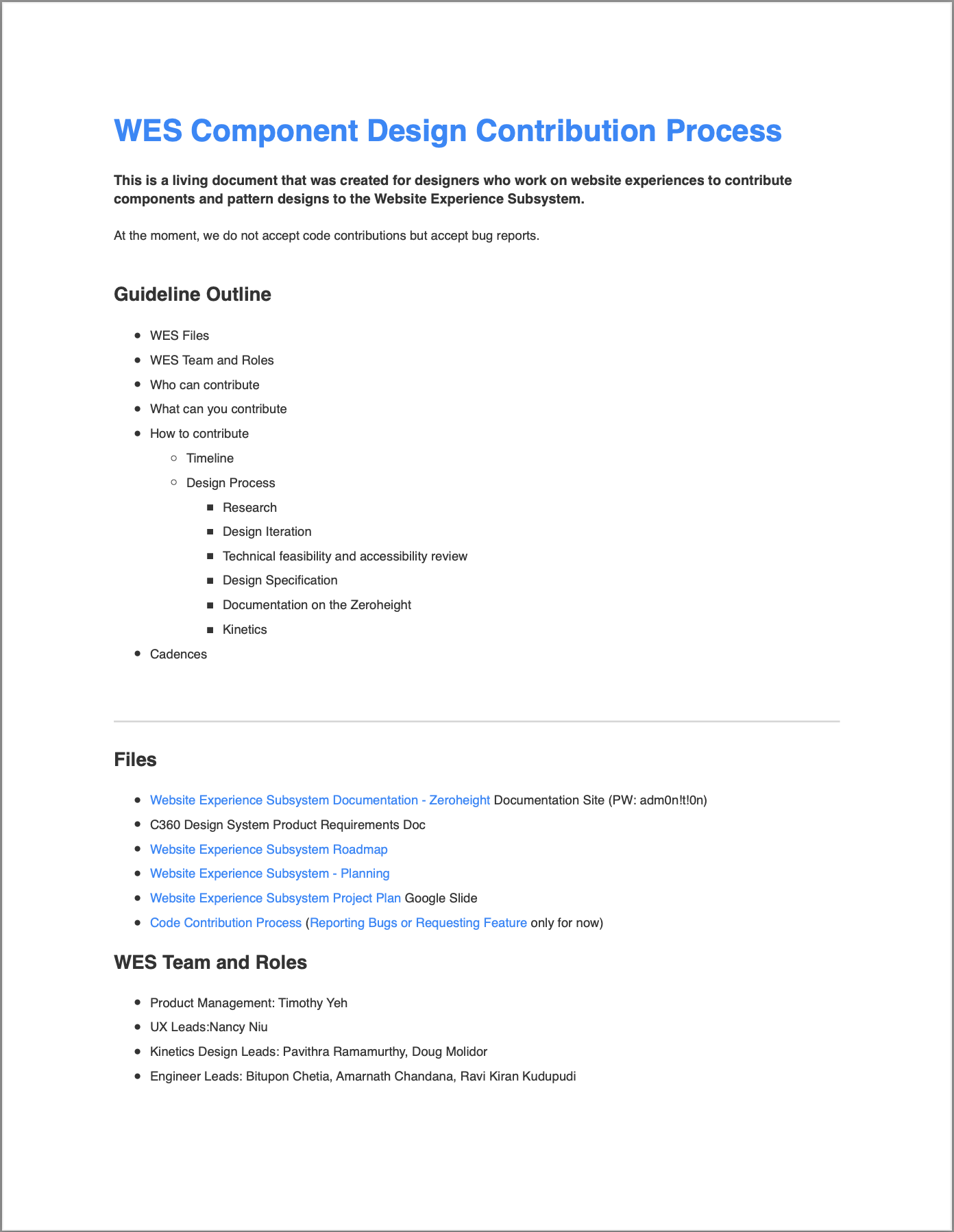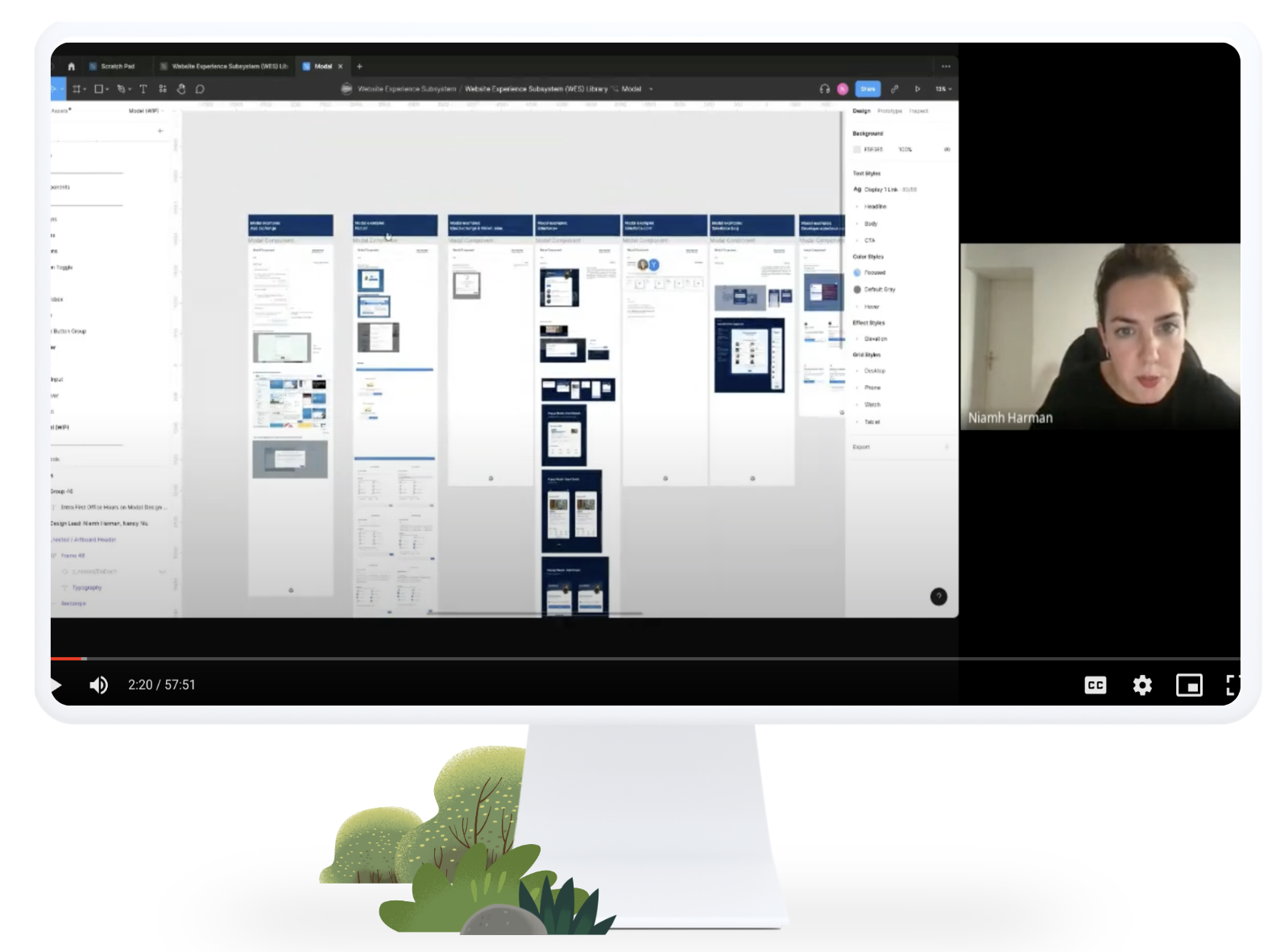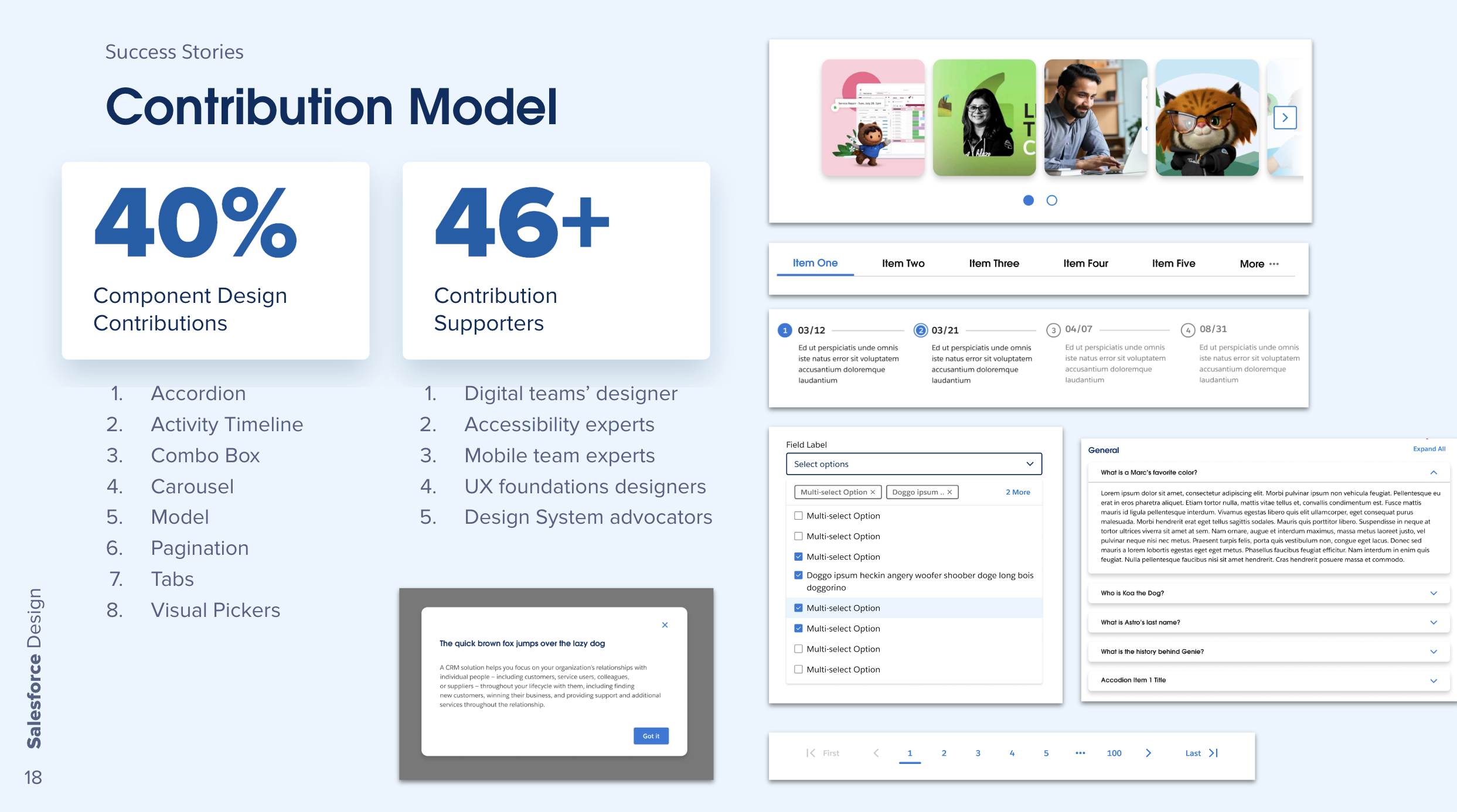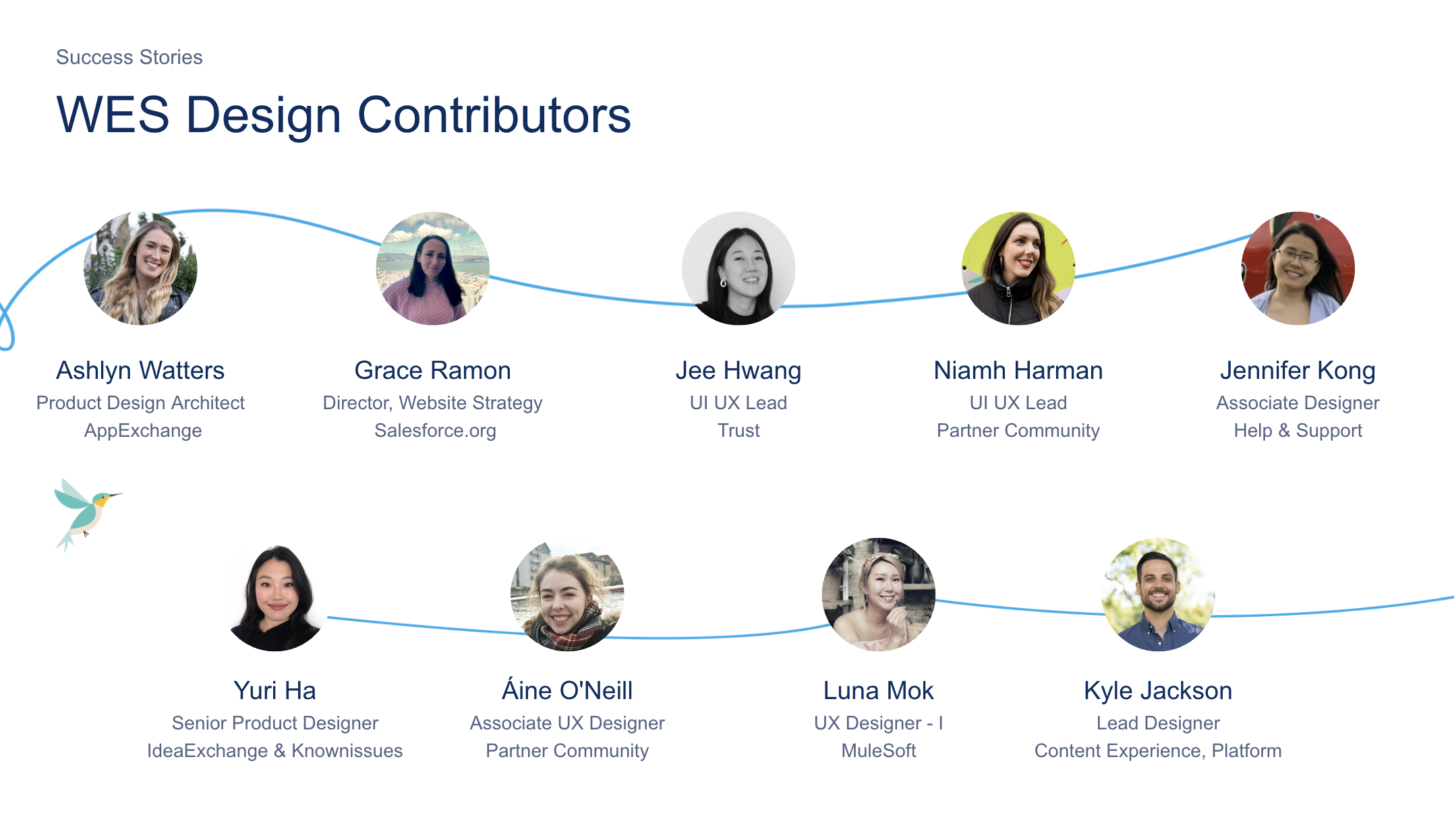Project Overview
Leading a small WES team, I recognized that our development process couldn't keep up with Salesforce's evolving digital needs. To address this, I launched a contribution program that empowers digital teams to create and adopt components, aligning websites with the unified WES design system.
Table of Contents
My Role
As a design and product leader, I collaborate closely with over 30 stakeholder teams to deliver components that meet their production needs. This role encompasses responsibilities in design leadership, product management, and program management.
Skills
Strategic Leadership
Stakeholder Management
Product Management
Design Leadership
Program Management
Challenges & Solutions
Initially, internal users were siloed within their teams, with limited cross-team collaboration. This made it difficult to solicit contributions, as each team was primarily focused on their priorities.
Solution: Applied Salesforce's Relationship Design principles to foster community and trust.
Building Connections: I conducted one-on-one meetings with design leads from 20 teams over six months to establish relationships and introduce WES.
Leading by Example: I demonstrated openness and encouraged knowledge-sharing by regularly sharing my work in progress.
Open Communication: I transformed the WES Slack channel into a support hub, providing timely answers to user questions and directing them to relevant resources. Biweekly updates on design, development, and release plans kept everyone informed and engaged.
Please refer to my Medium post for a deeper dive into how I used Relationship Design to drive engagement in the Design System.
Lack of Familiarity with Contribution: Internal users often lack understanding of the concept of contribution. They may not know what it entails to contribute to a design system or how to go about it, making it challenging to engage them in the contribution process.
Solution: Creating a Culture of Contribution





Promoting the Importance of Design Contribution: I engaged in discussions with designers about the significance of contributing to the design system and how it can benefit both them and the organization. I shared examples of successful contributions from other designers and highlighted the positive impacts they had achieved.
Offering Guidance Throughout the Process: I developed a comprehensive design system contribution guide that outlined the steps for contributing. Additionally, I made myself available to assist designers with any questions they had about the process, ensuring they felt supported.
Encouraging Contributions Through Rewards and Recognition: I showcased the work of designers who contributed to the design system on our documentation site and recognized them as design system contributors during all-hands meetings. To further incentivize participation, I also provided small rewards, such as gift cards, for their contributions.
Insufficient Support from Product and Design Managers: There is a noticeable lack of support from product and design managers regarding contributions. These managers may not fully recognize the importance of contribution or may lack the time and resources to facilitate it, creating obstacles for designers and developers aiming to contribute to the design system.
Solution: Empowering Designers to Contribute






Implementing a Design Checklist: I developed a design checklist that designers can use to verify that their contributions align with the standards of the design system.
Offering Templates: I created templates that designers can utilize to streamline the process of making their contributions.
Providing Coaching and Group Reviews for Improvement: I offered coaching sessions to help designers enhance their contributions and organized group reviews where they could receive feedback on their work from peers.
Limited Experience in Component Design: Most designers have little to no experience in designing components. This lack of skills and experience can hinder their ability to create components that meet the standards of the design system, making it difficult for them to participate in the contribution process.
Solution: Providing Support and Guidance
Offering Personalized Assistance: I made myself readily available to answer questions and provide support to designers contributing to the design system through direct messages and one-on-one meetings. These sessions allowed me to gather feedback on their contributions and offer tailored assistance.
Helping Designers Overcome Challenges: I actively supported designers in overcoming obstacles they encountered during the design system contribution process. Additionally, I provided resources and guidance to ensure their success.
Design Process Example
-
I conducted research to identify high-demand components and compiled a list for potential contributions. Internal users can select a component to design that aligns with their design background and meets their team’s needs.
-
In this step, I provided an overview of the component contribution process and set expectations based on the contributors' backgrounds:
Set a Timeline: The contribution process typically takes three times longer than that of a design system designer. To ensure progress and accountability, each design phase is framed within a timeline, and regular check-ins are conducted.
Decide on a Coaching Style: During the contribution process, some contributors may take the lead in presenting, iterating, testing, and documenting, while others may require ongoing encouragement and support at each stage.
-
I shared a list of Salesforce websites for internal audit, along with external design research that highlights how top design systems define their design scope.
-
In this phase, contributors receive a design template to ensure comprehensive coverage of all design aspects. They then present their work during WES office hours to gather feedback and ensure that the design meets the identified needs.
-
This phase involves finalizing the components and documenting them on Zeroheight, the platform where Salesforce’s internal subsystems are housed.
Result & Impact
A internal user shared her design contribution with the WES community in WES office hour
The Component Design Contribution process has significantly accelerated component development, with 40% of the components now contributed by internal users.
This initiative has cultivated a community culture and enhanced cross-team collaboration. It has led to strong advocacy for WES and myself, supported by diverse individuals.
There has been a 50% increase in WES Slack users over the past year, with a dedicated group of design leads actively participating in WES decision-making, including discussions on design requirements and component design priorities.
Additionally, more sites are becoming aware of the adoption process, including new platforms such as Salesforce Trailhead Academy and Salesforce Trust Availability.
Lessons Learned
This contribution model is particularly effective for emerging design systems seeking to expand their component library, especially for less intricate designs.
The model fosters a strong sense of community among design contributors, who actively promote the design system both during and after their contributions.








